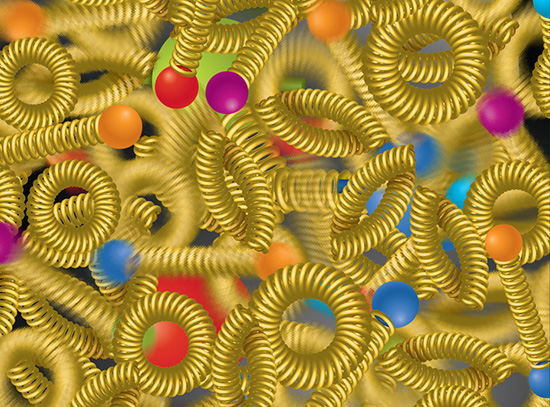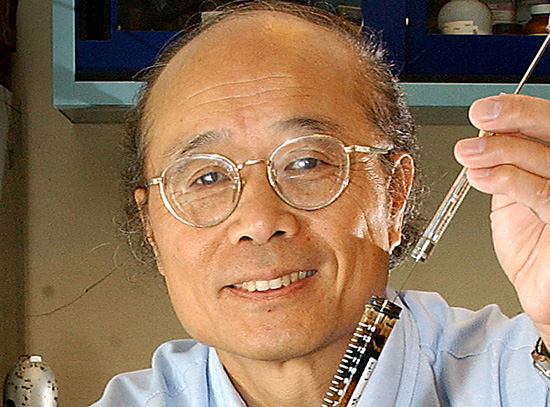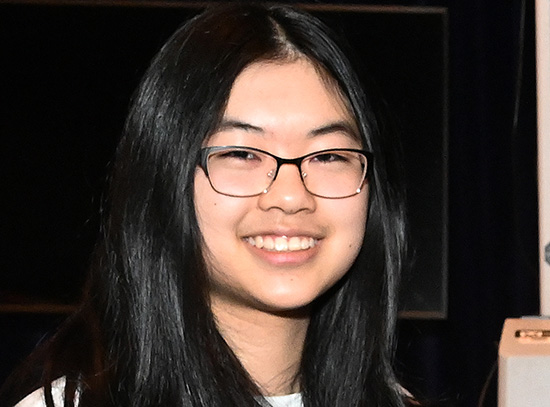DOE Renews Grants to NSLS Users
February 6, 2012
The Department of Energy has renewed two grants to user teams at the National Synchrotron Light Source. Both are funded for a period of three years.
Synchrotron Catalysis Consortium
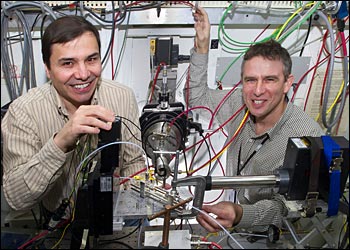
Jose Rodriguez (left), Brookhaven Lab, and Anatoly Frenkel, Yeshiva University, at beamline X19A
DOE’s Chemical Sciences, Geosciences & Biosciences Division granted $1.3 million to support the Synchrotron Catalysis Consortium for continuing catalysis research that began in 2005, when University of Delaware Professor Jingguang Chen, Yeshiva University Professor Anatoly Frenkel and Brookhaven Senior Chemist Radoslav Adzic led a group of colleagues from academia, industry and national labs in founding the consortium to promote the use of synchrotron techniques for cutting-edge catalysis research.
“This is the consortium’s third consecutive grant from DOE,” said Frenkel, who also noted that catalysis has long been a major area of research in the U.S. because of its importance to industry, particularly for chemical and petroleum companies. Today, catalysts are proving valuable in others areas as well, including environmental and bioengineering applications.
The scientists use x-ray absorption fine-structure (XAFS) spectroscopy at NSLS as a primary method of catalysis research, to measure how a material absorbs x-rays. They also develop complementary, synchrotron-based methods of catalysis research using multi-technique instruments.
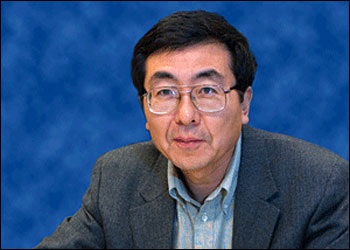
Jingguang Chen, University of Delaware
“Among most techniques, XAFS stands out in its ability to yield atomic-scale information about a material’s structural, electronic and thermal properties. Thus, it’s perfect for studies of nanoscale catalysts,” explained Frenkel.
Using beamlines X18A, X18B and X19A, the consortium has designed over a dozen specialized reaction cells and advanced characterization techniques tailored to catalysis research. Accordingly, their work has impacted over a hundred research groups in the U.S. catalysis community.
The current grant is with Chen, Frenkel and Brookhaven Senior Chemist Jose Rodriguez as principal investigators (PIs), with U. of Delaware team members Emily Carino, Ned Marinkovic and Adele Wang on location full-time at NSLS, and with a group of co-PIs and collaborators from academic, national laboratory and industrial institutions.
Going forward, the team will work on making the transition to NSLS-II, enabling further insight into the chemical and physical structure of materials. They have already started making plans to continue their research using several NSLS-II beamlines.
“The new capabilities of NSLS-II will allow much faster acquisition of data with spatial resolution that will make possible true kinetic studies of catalytic processes and the imaging of catalysts under working conditions,” said Rodriguez.
Geosciences
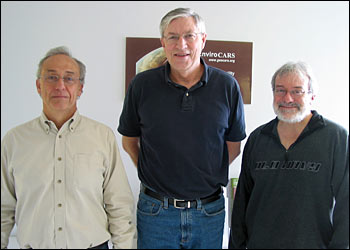
Mark Rivers (left), Steve Sutton and Tony Lanzirotti, University of Chicago
University of Chicago Principal Investigator Steve Sutton, Senior Research Associate Tony Lanzirotti, Senior Scientist Mark Rivers and Beamline Scientist Sue Wirick are joined by Principal Investigator Paul Bertsch and Beamline Technician Bill Rao of the University of Kentucky on a $673,430 DOE grant to continue geoscience research at NSLS beamline X26A. Their work, which began in 1992, is focused on low-temperature chemistry and environmental issues and is also funded by DOE’s Chemical Sciences, Geosciences & Biosciences Division.
“We develop and use the x-ray microprobe at beamline X26A to achieve the high sensitivity and high spatial resolution that’s crucial for understanding the chemical properties of complex earth materials and environmental samples,” said Sutton. “This microbeam instrument is under high demand for its flexibility in analyzing samples in many forms and its capability for multiple, hard x-ray techniques, such as fluorescence, absorption spectroscopy, diffraction, and tomography.”
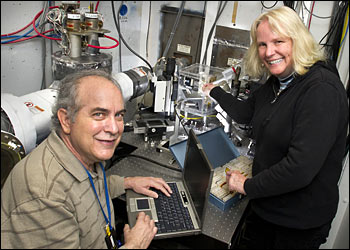
Bill Rao (left), University of Kentucky, and Sue Wirick, University of Chicago, at beamline X26A
Sutton described research supported by the previous DOE grant as encompassing a wide range of scientific problems within the earth and environmental sciences including:
- geochemistry and bioaccessibility of toxic metals and metalloids in contaminated sediments and particulates
- evaluation of metal uptake mechanisms by geosynthetic clay liners
- determination of the pressure effect in the titanium-in-quartz thermometer
- use of iron oxidation state as a proxy for oxygen fugacity in silicate melts and the role of water in subduction zones
- mineralogic sources of uranium in well water
- complexation of molybdenum by organic matter in soils
- speciation, bioavailability and biomagnification of metals in nanoparticles
Under the current grant, the team – working with collaborators from other institutions – will focus on thirteen specific projects, including:
- metal speciation and mineralogy in mine waste and drainage waters
- fluid transport properties of mineral surfaces in shallow unsaturated zones and deep geologic carbon dioxide sequestration reservoirs
- evaluating leakage risks from geologic carbon dioxide storage reservoirs
- oxidation states of silicate melts
- impacts of engineered nanoparticles in the environment
- biotic sequestration of lead in contaminated soils
Sutton added that the researchers are already participating in the planning for NSLS-II. “The new facility is scheduled to begin operations as early as 2014, and our goal is to have the earth and environmental science community as one of the first to conduct experiments there.” He pointed out that members of the group are part of the advisory team for SRX, one of the six initial beamlines now under construction, and are also part of the proposal team for another approved beamline, XFM.
2012-2881 | INT/EXT | Newsroom




